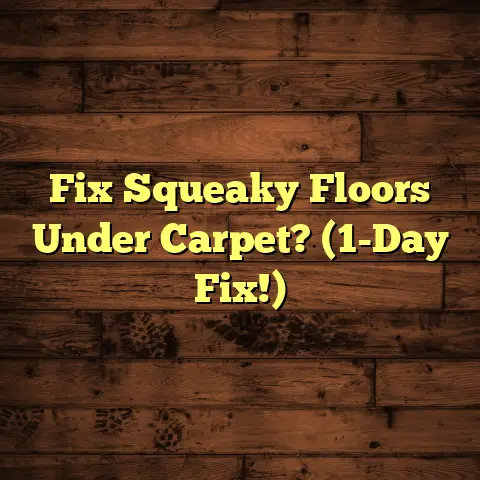Seasonal Flooring Maintenance: How? (4 Steps Now!)
And let me tell you, I’ve seen it all when it comes to floors.
From water damage disasters to pet stain nightmares, I’ve helped countless folks rescue their beloved floors.
But you know what’s even better than fixing a problem?
Preventing it in the first place!
That’s where seasonal flooring maintenance comes in.
It’s not just about keeping your floors looking pretty, it’s about creating a healthier home for you and your family.
Let’s dive into why this matters and how you can easily tackle it in just four steps!
Understanding the Importance of Seasonal Flooring Maintenance
So, what exactly is seasonal flooring maintenance?
Think of it as a regular check-up for your floors, adjusted to the changing weather.
Just like your car needs different care in winter compared to summer, so do your floors.
Why is this so crucial?
Well, the environment impacts your flooring more than you might think.
- Hardwood: Expands and contracts with humidity.
- Tile: Can crack with freezing temperatures, especially outdoors.
- Carpet: Traps more allergens in the spring and summer, and moisture in the fall and winter.
- Laminate: Susceptible to warping from excess moisture.
And guess what?
All that dirt, dust, and those allergens your floors collect can seriously affect your health.
According to the EPA, indoor air can be two to five times, or even more, polluted than outdoor air.
And floors are a major culprit!
Think about it:
Dust mites, pet dander, mold spores, and bacteria love to hang out in your carpets and crevices.
This can lead to:
- Respiratory issues like asthma and allergies
- Skin irritations
- Weakened immune system
By keeping your floors clean and well-maintained, you’re not just improving your home’s appearance, you’re creating a healthier living environment.
Step 1 – Inspection and Assessment
Alright, time to put on your detective hat!
The first step in seasonal flooring maintenance is a thorough inspection.
Grab a notepad and pen (or your phone) and let’s get started.
Here’s a checklist of common issues to look for:
- Scratches: Especially on hardwood and laminate.
- Stains: From spills, pets, or tracked-in dirt.
- Cracks: In tile, grout, or concrete.
- Gaps: Between hardwood planks.
- Loose Tiles: Or planks.
- Wear and Tear: In high-traffic areas.
- Moisture Damage: Water stains, mold, or mildew.
- Cupping or Crowning: In hardwood (signs of moisture issues).
Now, consider the season:
- Spring: Look for signs of moisture from melting snow or spring rains.
- Summer: Check for sun damage on hardwood floors near windows.
- Fall: Be on the lookout for leaves, mud, and debris tracked in from outdoors.
- Winter: Pay attention to salt damage from boots and potential water damage from snow and ice.
Document everything!
Take pictures, write down the location and severity of each issue.
This will help you track the progress of your maintenance efforts and identify any recurring problems.
Pro Tip: I always tell my clients to create a simple spreadsheet to keep track of their findings.
It makes it so much easier to compare year to year!
Step 2 – Cleaning and Deep Cleaning
Now for the fun part: cleaning!
Regular cleaning is essential for removing dirt, dust, and allergens that accumulate over time.
Here’s a quick rundown of basic cleaning procedures for different flooring types:
- Hardwood: Sweep or vacuum regularly, and mop with a wood-specific cleaner.
- Tile: Sweep or vacuum, and mop with a tile cleaner.
- Carpet: Vacuum at least twice a week.
- Laminate: Sweep or vacuum, and mop with a laminate-specific cleaner.
But sometimes, regular cleaning isn’t enough.
That’s where deep cleaning comes in.
Deep cleaning involves using more powerful cleaning solutions and tools to remove stubborn stains, odors, and deeply embedded dirt.
Here are some deep cleaning tips for each flooring type:
- Hardwood: Use a wood floor cleaner and a scrub brush to remove tough stains. Avoid excessive water, which can damage the wood.
- Tile: Use a grout brush and a tile cleaner to scrub away dirt and grime from the grout lines. Consider using a steam cleaner for a deeper clean.
- Carpet: Rent a carpet cleaner and use a carpet cleaning solution to remove deep-seated dirt and allergens. Consider professional cleaning for best results.
- Laminate: Use a laminate floor cleaner and a damp mop to remove stubborn stains. Avoid using too much water, which can seep into the seams and cause damage.
For tough stains, try these solutions:
- Pet stains: Use an enzymatic cleaner to break down the stain and odor.
- Grease stains: Use a degreasing cleaner.
- Red wine stains: Blot immediately and then apply a paste of baking soda and water.
- Ink stains: Use rubbing alcohol.
I can’t stress enough the importance of removing allergens.
Carpets, in particular, can trap a shocking amount of allergens.
Studies have shown that regular vacuuming can reduce allergen levels by up to 80%!
So, grab that vacuum and get to work!
Step 3 – Repairs and Refinishing
Okay, so you’ve inspected and cleaned your floors.
Now it’s time to address any damage you found.
Minor repairs, like filling in scratches or replacing damaged tiles, are relatively easy to do yourself.
For scratches on hardwood or laminate, you can use a touch-up pen or a wood filler.
For damaged tiles, carefully remove the old tile and replace it with a new one, using tile adhesive and grout.
But what about more extensive repairs?
When should you call in a professional?
Here are a few signs that it’s time to call an expert:
- Extensive water damage: If your floors are warped, buckled, or have mold, it’s best to call a professional.
- Large cracks in tile or concrete: These can be a sign of structural issues.
- Loose or uneven subfloor: This needs to be addressed before installing new flooring.
- You’re not comfortable doing the repairs yourself: It’s always better to be safe than sorry!
Now, let’s talk about refinishing hardwood floors.
Refinishing involves sanding down the old finish and applying a new one.
This can completely transform the look of your floors and make them look brand new.
The basic steps of refinishing hardwood floors are:
- Sanding: Use a drum sander to remove the old finish.
- Staining (optional): Apply a stain to change the color of the wood.
- Sealing: Apply a sealant to protect the wood from moisture.
- Finishing: Apply several coats of polyurethane to protect the wood from wear and tear.
Refinishing hardwood floors is a big job, and it’s not for everyone.
If you’re not comfortable doing it yourself, I highly recommend hiring a professional.
Timely repairs are crucial for preventing further damage.
A small crack in a tile can quickly turn into a major problem if water seeps in and damages the subfloor.
And remember, a healthy home starts with healthy floors.
By addressing damage promptly, you’re preventing the growth of mold and mildew, which can trigger allergies and respiratory issues.
Step 4 – Protective Treatments and Seasonal Preparation
Alright, you’ve inspected, cleaned, and repaired your floors.
Now it’s time to protect them!
Protective treatments can help prolong the life of your flooring and keep it looking its best.
Here are some protective treatments to consider:
- Hardwood: Apply a sealant to protect the wood from moisture and scratches.
- Tile: Apply a grout sealer to prevent stains and mildew.
- Carpet: Apply a stain repellent to protect against spills.
- Laminate: Use a laminate floor protector to prevent scratches and wear.
Seasonal preparation is also key.
Here are some tips for preparing your floors for each season:
- Spring: Place mats at entrances to trap dirt and mud. Clean your floors regularly to remove allergens.
- Summer: Use curtains or blinds to protect hardwood floors from sun damage. Consider using area rugs in high-traffic areas.
- Fall: Place mats at entrances to trap leaves and debris. Clean your floors regularly to remove dirt and mud.
- Winter: Use mats at entrances to trap salt and moisture. Consider using a humidifier to prevent hardwood floors from drying out.
Here are a few product recommendations:
- Hardwood Floor Cleaner: Bona Hardwood Floor Cleaner
- Tile and Grout Cleaner: Grout-Eez Super Concentrate Grout Cleaner
- Carpet Stain Remover: Bissell Professional Pet Stain & Odor Remover
- Laminate Floor Cleaner: Weiman Laminate Floor Cleaner and Polish
DIY Treatment Option:
For hardwood floors, a mixture of equal parts white vinegar and water can be used as a natural cleaner.
However, always test it in an inconspicuous area first to make sure it doesn’t damage the finish.
Preventative measures are key to prolonging the life of your flooring.
By taking a few simple steps, you can protect your floors from damage and keep them looking their best for years to come.
And remember, a safe living environment starts with well-maintained floors.
By preventing slips, trips, and falls, you’re protecting yourself and your family from injury.
Conclusion
So, there you have it!
Seasonal flooring maintenance in four easy steps.
Remember, maintaining your flooring is not just about aesthetics; it’s about creating a healthier and safer home for you and your loved ones.
By following these simple steps regularly, you can ensure that your floors remain in optimal condition for years to come.
To recap:
- Inspect and Assess: Identify any damage or issues.
- Clean and Deep Clean: Remove dirt, dust, and allergens.
- Repair and Refinish: Address any damage promptly.
- Protective Treatments and Seasonal Preparation: Protect your floors from future damage.
Don’t wait until you have a major flooring problem to take action.
Start implementing these practices today and enjoy the benefits of a clean, healthy, and beautiful home.
Now, I want to hear from you!
What are your biggest flooring challenges?
What are your favorite cleaning tips?
Share your thoughts in the comments below!
And remember, I’m always here to help.
If you have any questions or need advice, don’t hesitate to reach out.
Happy flooring!





